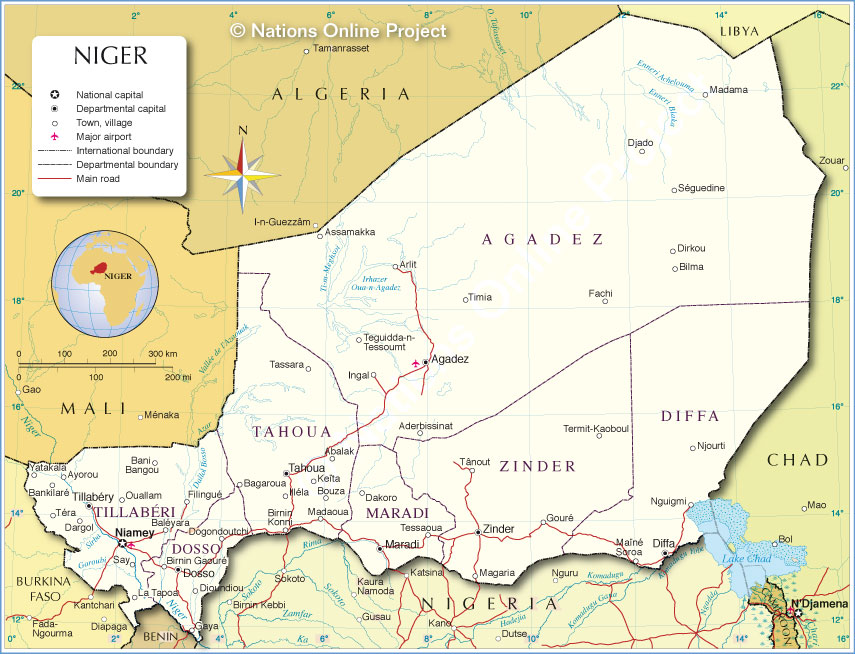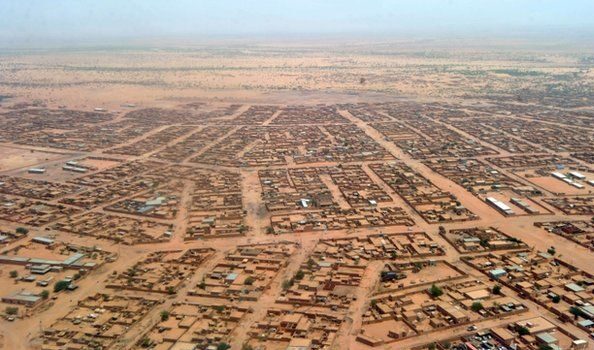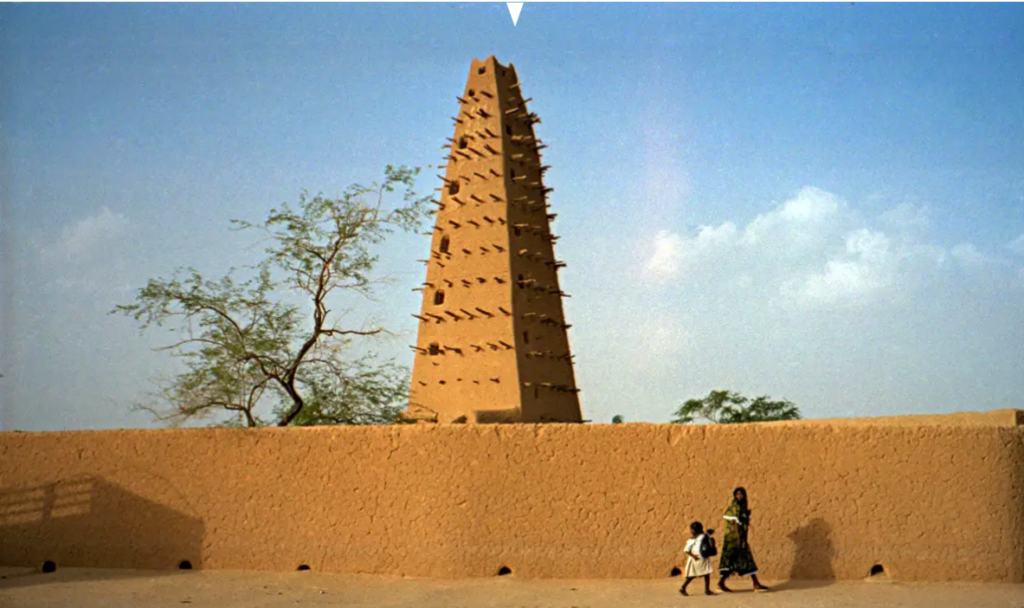អាហ្គាដេស ( Agadez) គឺជាឈ្មោះ នៃតំបន់ពាណិជ្ជកម្មសំខាន់មួយនៅក្នុងតំបន់វាលខ្សាច់សាហារ៉ា (Sahara desert) ដែលមានទីតាំងស្ថិតនៅក្នុងប្រទេសនីហ្សេ (Niger)។ ប្រវត្តិសាស្រ្តនៃតំបន់អាហ្គាដេស គឺគិតពីពេលដែលស្តេច សូតាន់ Aïr បានមកតាំងទីនៅទីនេះចាប់ពីស.វ.ទី១៥ ទៅ ស.វ.ទី១៦គ.ស. និងបានអភិវឌ្ឍន៍អាហ្គាដេសទៅជាតំបន់ជួញដូរពាណិជ្ជកម្មក្នុងតំបន់សាហារ៉ា និងក្នុងទ្វីបអាហ្វ្រិកខាងលិច។

ប្រភព៖ Nations online projet
ការអភិវឌ្ឍន៍នៅទីនេះ គឺបានភ្ជាប់ផ្លូវពាណិជ្ជកម្មពីភាគខាងកើតនៃប្រទេសអាល់ហ្សេរី ទុយនេស៊ី និងលីប៊ី ទៅតំបន់សាហេល ដែលស្ថិតចន្លោះ នៃទន្លេនីហ្សេ និងទន្លេឆាដ។ ចាប់ពីពេលនោះមក ទីនេះក៏បានក្លាយជាតំបន់ផ្លាស់ប្តូរពាណិជ្ជកម្ម និងក៏ជាទីក្រុងវប្បធម៌ អរិយធម៌ ដែលហៅថា Gateway to the desert។
ចំពោះការរៀបចំក្រុងនៅអាហ្គាដេស បែងចែកជា១១សង្កាត់ ដែលការបែងចែកនេះ គឺនៅអំឡុងពេលដែលទីក្រុងនេះស្ថិតនៅក្នុងអាណានិគមបារាំង ដែលក្នុងសង្កាត់ទាំងនោះ គឺមានសំណង់ប្រវត្តិសាស្រ្តជាច្រើន។ គួរបញ្ជាក់ដែរថា បារាំងបានគ្រប់គ្រងតំបន់អាហ្គាដេស នៅឆ្នាំ ១៩០៤ និងមានឯករាជ្យភាពនៅឆ្នាំ ១៩៦០ ពោលការគ្រប់គ្រងគឺមានរយៈពេលជាង៥៦ឆ្នាំ។ សំណង់ប្រវត្តិសាស្រ្តទាំងនោះ បានបែងចែកជា១៨ក្រុម ភាគច្រើនគឺជាផ្ទះប្រពៃណីដែលធ្វើពីដីឥដ្ឋ រាជវាំង ព្រះវិហារ ទីតាំងសាធារណៈ ផ្សារ ជាដើម។ ទីក្រុងនេះ មានប្រជាជនរស់នៅប្រមាណជាង ២០,០០០។ ចាប់ពីសតវត្សទី១៥ មក អាហ្គាដេសគឺជា ច្រកទ្វារពាណិជ្ជកម្មដ៏សំខាន់។

ប្រភព៖ BBC

ប្រភព៖ https://whc.unesco.org
ព្រះរាជវាំងរបស់ស្តេច សូតាន់ Aïr គឺមានអាយុកាលកសាងនៅស.វ.ទី១៥គ.ស. ដែលនៅទីនោះ មានជារាជដំណាក់ ជាច្រើន ដែលមានការតុបតែងតាមបែបប្រពៃណីនៃ នីហ្សេ និងមានកំពែងប្រមាណជាង ១ហិតាកន្លះ។
បន្ទាប់មកទៀតគឺជាសំណង់ដីខ្ពស់មួយដែលហៅថា ព្រះវិហារនៃអាហ្គាដេស (Grand Mosque of Agadez) ស្រដៀងទៅនឹងផ្នូររបស់ស្តេច Askia muhammad ដែលជាស្តេចដ៏មានកេរ្តិ៍ឈ្មោះល្បីល្បាញ និងមានឥទ្ឋិពលម្នាក់នៅក្នុងអរិយធម៌សុងហៃ និងនៅក្នុងតំបន់អាហ្រ្វិចខាងលិច។ សំណង់ព្រះវិហារនេះត្រូវបានកសាងនៅស.វ.ទី១៦គ.ស.។ ការកសាងសំណង់នេះ គឺធ្វើអំពីដីខ្ពស់ទៅលើ ដោយបង្កប់ជន្លួញឈើនៅជុំវិញសំណង់ដីនោះ។ នៅសម័យកាលនោះ ស្តេច Aïr គឺមានឥទ្ឋិពលខ្លាំងបានពង្រីកទឹកដីនៃទីក្រុង អាហ្គាដេសកាន់តែធំជាបន្តបន្ទាប់។
ក្រៅពីនេះ ក៏មានសំណង់ព្រះវិហារ ផ្សេងទៀត ដូចជាព្រះវិហារ Tendé និង Abawagé ដែលកសាងនៅស.វ.ទី ១៦គ.ស.។ ព្រះរាជវាំង Anastafidet កសាងនៅដើមស.វ.ទី២០ ជាដើម។ តំបន់នៃទីក្រុងនេះ អាហ្គាដេស ក៏ត្រូវបានចុះក្នុងបញ្ជីសម្បត្តិបេតិកភណ្ឌពិភពលោកក្នុងឆ្នាំ ២០១៣ ក្នុងផ្ទៃដី ៧៧ហិតា។
សរុបសេចក្តីមក អាហ្គាដេស គឺជាទីក្រុង ដ៏សំខាន់នៅក្នុងប្រវត្តិសាស្រ្ត នៃប្រទេស នេហ្សេ និងក្នុងតំបន់ទ្វីបអាហ្វ្រិកខាងលិច។ ក្នុងរជ្ជកាលរបស់ស្តេច សូតាន់ Aïr បានធ្វើឱ្យ អាហ្គាដេស មានការរីកចម្រើនយ៉ាងខ្លះ ដែលបានបង្ហាញតាមរយៈសំណង់ស្ថាបត្យកម្ម និងវិសាលភាពទឹកដីដ៏ធំធេង និងបង្ហាញអំពីបច្ចេកទេសយ៉ាងល្អក្នុងការកសាងសំណង់ទាំងនោះ។ រហូតដល់ពេលបច្ចុប្បន្ន អាហ្គាដេស ក៏នៅតែជាច្រកទ្វារពាណិជ្ជកម្ម និងទេសចរណ៍ក្នុងតំបន់សាហារ៉ា៕
———————————
Agadez Region
Agadez is the name of an important commercial area in the Sahara Desert, located in Niger. The history of Agadez is from the period of king Sultan of Aïr, who settled here from the 15th century to the 16th century and developed Agadez to become a trading area in the Sahara and in West Africa.
The development here connects trade routes from eastern Algeria, Tunisia, and Libya to the Sahel, between the Niger and Chad rivers. Since then, this area has also become a trade exchange zone and also a cultural and civilized city called Gateway to the desert.
The city of Agadez was divided into 11 districts, during which time the city was under French colonization, with many historic buildings. It should be noted that France ruled Agadez in 1904 and gained independence in 1960, that is, more than 56 years. The historic buildings are divided into 18 groups, mostly traditional clay houses, palaces, churches, public places, markets, etc. The city has a population of over 20,000. Agadez was an important commercial gateway since the 15th century.
The palace of King Sultan of Aïr was built in the 15th century. There are many palaces decorated in the traditional style of Niger and with walls of more than one and a half hectares.
Another structure is a tall clay structure called the Grand Mosque of Agadez, similar to the tomb of King Askia Muhammad, a famous and influential king in the Shanghai civilization and in west Africa. This church was built in the 16th century. The construction is made of clay by embedding wooden beams around the structure. At that time, King Sultan of Aïr was very influential and gradually expanded the territory of Agadez.
There are also other temples, such as the Tendé and Abawagé, built in the 16th century. Anastafidet Palace was built in the early 20th century. The city of Agadez was also inscribed on the World Heritage List in 2013 for an area of 77 hectares.
In conclusion, Agadez is an important city in the history of Niger and in West Africa. During the reign of King Soltane of Aïr made some progress in Agadez, which was demonstrated through the architectural, large territorial, and illustrated the fine techniques used to construct them. To this day, Agadez is still a gateway for trade and tourism in the Sahara.
អត្ថបទដោយ៖ លោក អេង តុលា






